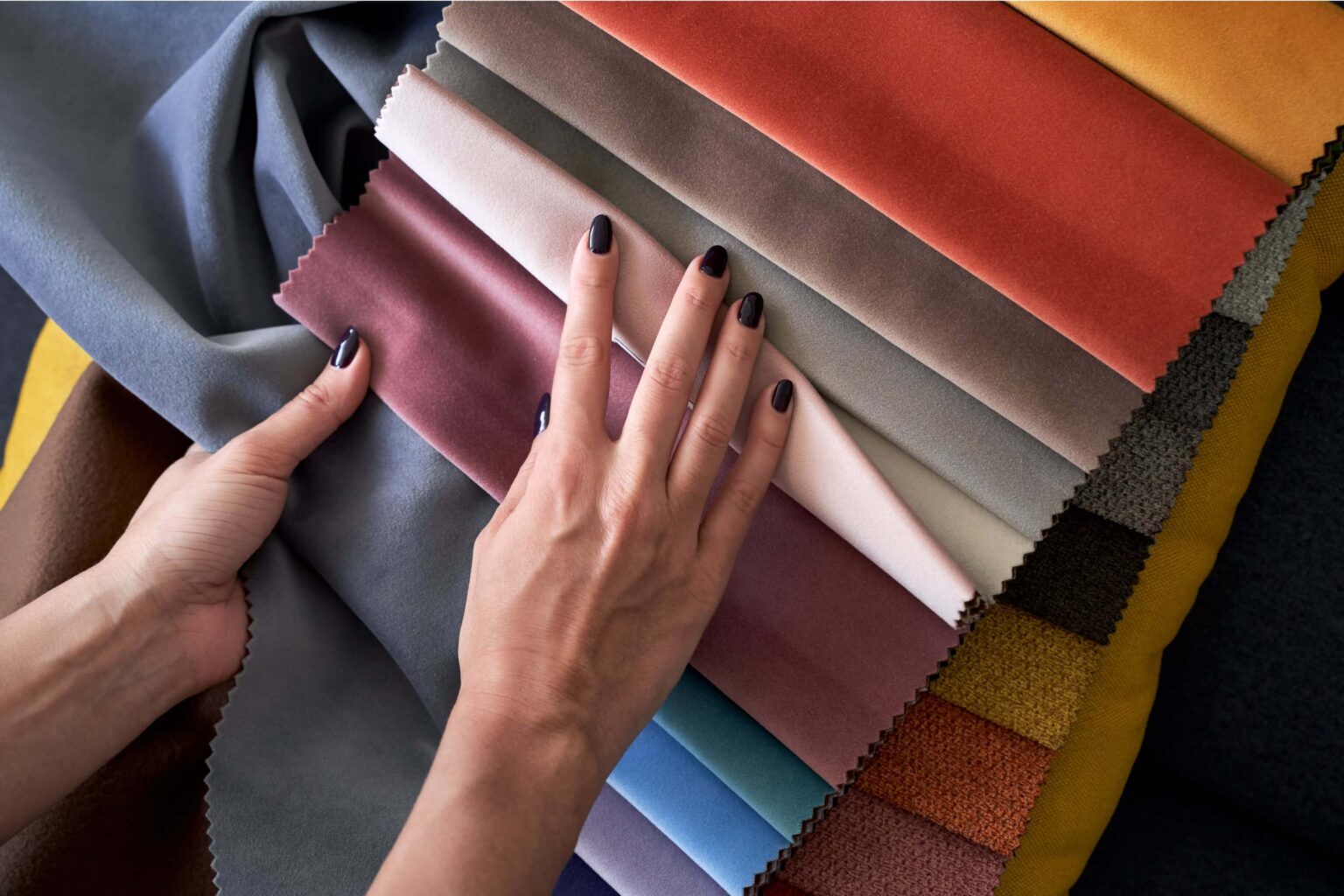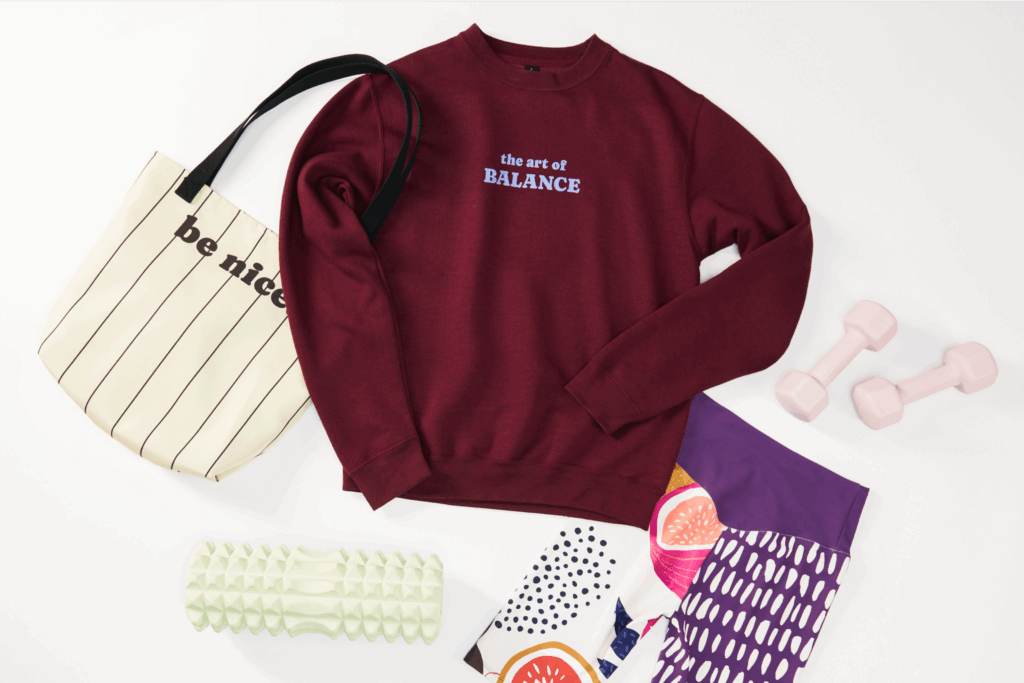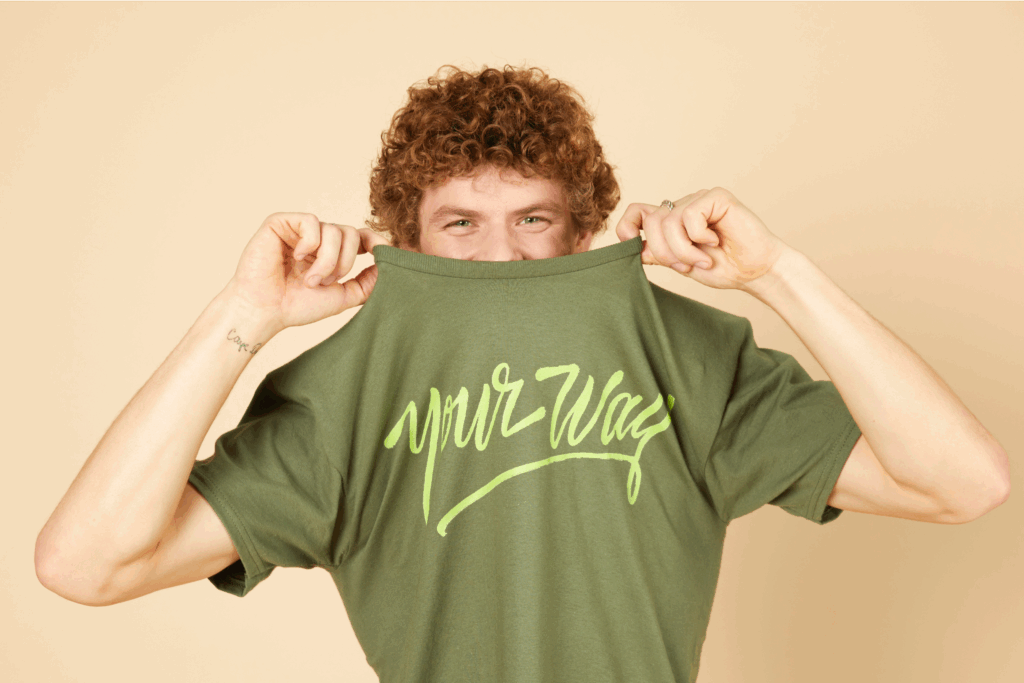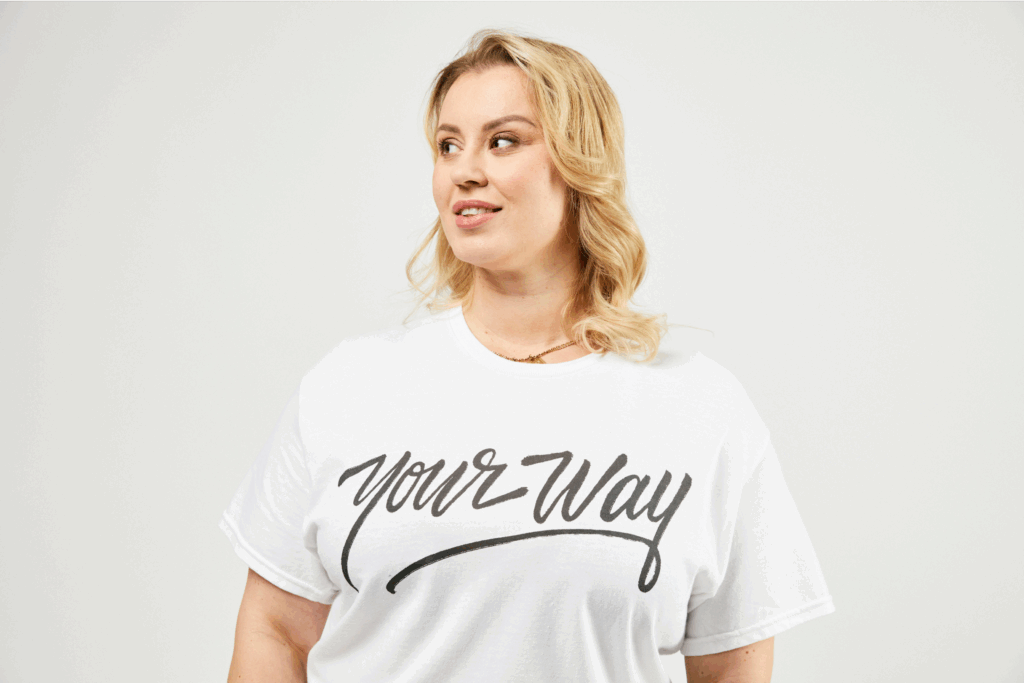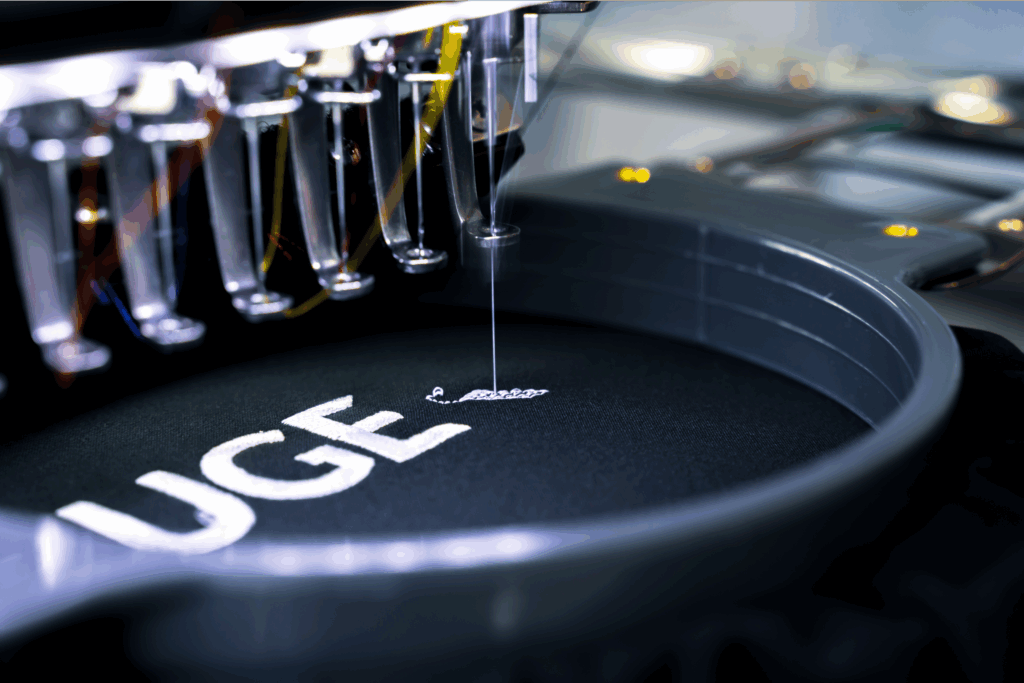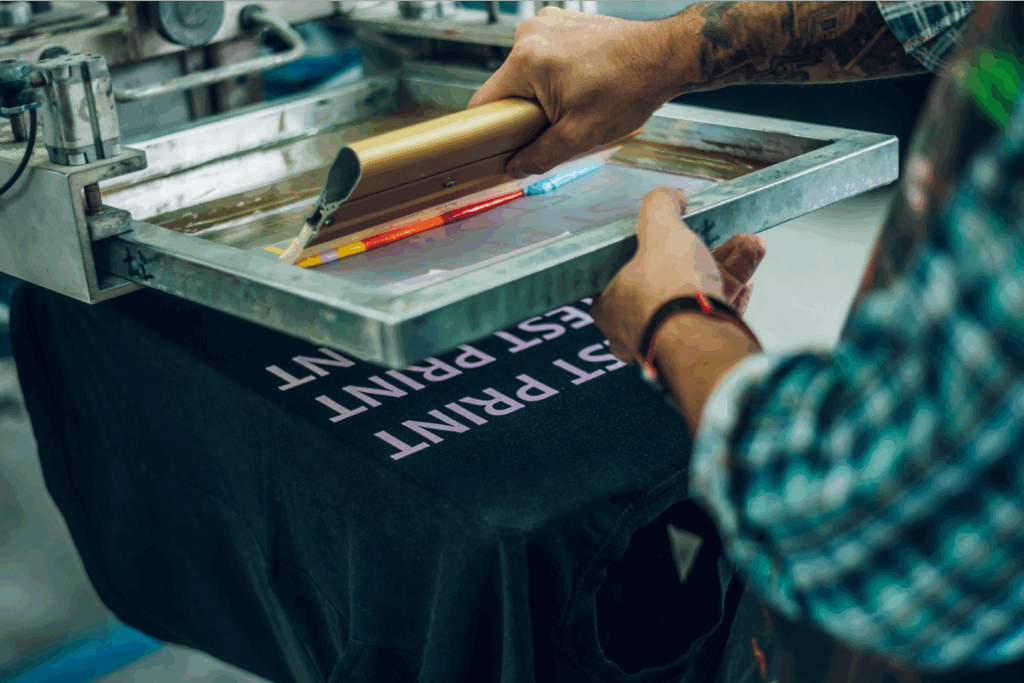Design custom products with Printify
Polyester is known for its durability, but is polyester stretchy? While 100% polyester lacks natural stretch, certain manufacturing techniques and blends help add flexibility.
Let’s explore everything about polyester, from its stretchability to its production process, and more.
Key takeaways
- Polyester is a synthetic material known for its durability and versatility.
- The stretchability of polyester fabric depends on the blend and type of weave used in production.
- Manufacturers blend polyester with elastic fabrics like spandex or elastane to enhance comfort and fit.
- Polyester fabric is suitable to use in Print on Demand for direct-to-garment and all-over prints.
What is polyester?
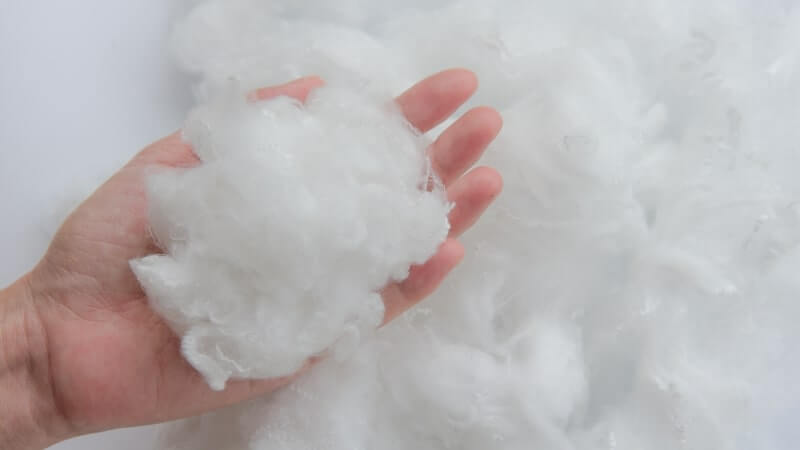
Polyester is a synthetic material made from polyethylene terephthalate (PET) fibers, the same plastic found in water bottles.
Known for its cost-effectiveness, durability, and versatility, polyester is prevalent in the fashion industry, from outerwear to activewear.
Its durability also makes it ideal for household and industrial products like ropes and air filters.
The pros and cons of polyester
Pros:
- Durability – Polyester is known for its long-lasting strength, making it ideal for clothing, home goods, and industrial products.
- Wrinkle-resistant – One of the key advantages of polyester is its ability to maintain a smooth, wrinkle-free look without constant ironing.
- Moisture-wicking – Unlike natural fabrics such as cotton, polyester quickly draws moisture away from the skin, keeping you dry during physical activities.
- Shrink and stretch resistance – Polyester holds its shape well, even after frequent washing and wear.
- Cost-effective – It’s a budget-friendly option for businesses looking to produce durable, high-quality garments.
Cons:
- Breathability – Polyester can feel less breathable than natural fibers, which may cause discomfort in hot climates.
- Texture – Wondering what does polyester feel like? Some people find it less soft compared to cotton or rayon.
- Odor retention – Polyester tends to trap odors, which can be an issue in activewear unless treated for odor resistance.
- Environmental concerns – Polyester is made from petroleum-based materials, raising sustainability concerns despite advancements in recycling techniques.
Is polyester stretchy?
Polyester itself is not inherently stretchy, but it can offer flexibility depending on its weave or blend with elastic fibers.
Knitted polyester and blends with spandex or elastane are go-to options for those looking for a stretchier fabric. This combination provides comfort, movement, and durability – ideal for activewear and fitted garments.
Factors that affect polyester stretchability
There are several factors that affect how stretchy polyester is, including the type of polyester, the weaving method, and the fabric thickness.
Material combinations like a poly-cotton blend offer greater elasticity and comfort, while a plain weave tends to hold its shape and negatively affect the stretchiness of polyester.
Should you size up with 100% polyester?
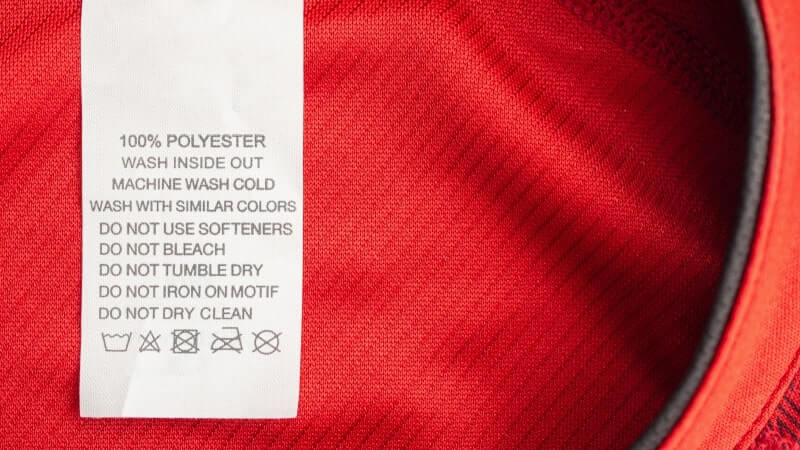
Since 100% polyester has minimal stretch, we recommend sizing up for a more comfortable fit, especially in form-fitting or tight clothing.
Sizing up supports ease of movement without relying on the fabric’s elasticity, which is often absent in pure polyester garments.
Is polyester more stretchy than cotton?
Pure polyester is less stretchy than cotton. Polyester resists water and maintains its structure, while cotton fibers naturally absorb water and offer slight stretch over time.
However, when blending with elastic fibers like spandex, polyester can become much more flexible than cotton, making it ideal for activewear and fitted garments.
How is polyester made?
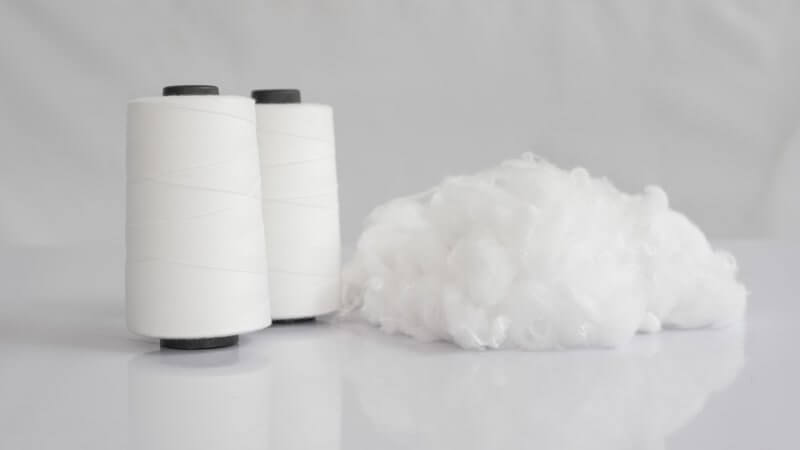
Manufacturers produce polyester using two main methods – from raw materials or by recycling plastic.
Both methods create a durable, wrinkle-resistant, and versatile material that is suitable for various products, from t-shirts to pet bandanas.
Let’s take a closer look at each production method.
Polyester made from raw materials
When making polyester from scratch, the main ingredient is ethylene glycol derived from petroleum. Manufacturers react ethylene glycol with dimethyl terephthalate (DMT) or terephthalic acid (TPA) to create a monomer, which undergoes polycondensation to form a polymer.
Next, the producer melts the polymer and extrudes it to form long strands, which are then cut into small PET pellets.
Operators melt and push these pellets through a machine like an oversized sieve to create large threads. Once they cool down, they’re twisted together to make polyester yarn.
Polyester made from recycled plastic
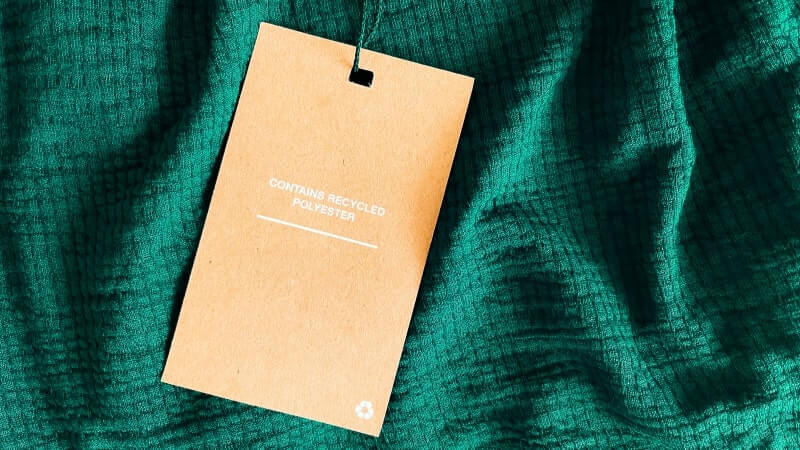
Recycled polyester production begins with collecting used plastic items like bottles. Manufacturers sort these items into clear and dyed plastic, then wash them to remove all contaminants.
After sorting, they clean and dry the plastic thoroughly to make sure it’s free from impurities.
The process continues with melting and extrusions, just like in the previous method.
This recycling technique not only reduces plastic waste but also produces a versatile and durable fabric suitable for various applications, from clothing to home goods.
Different types of polyester blend fabrics
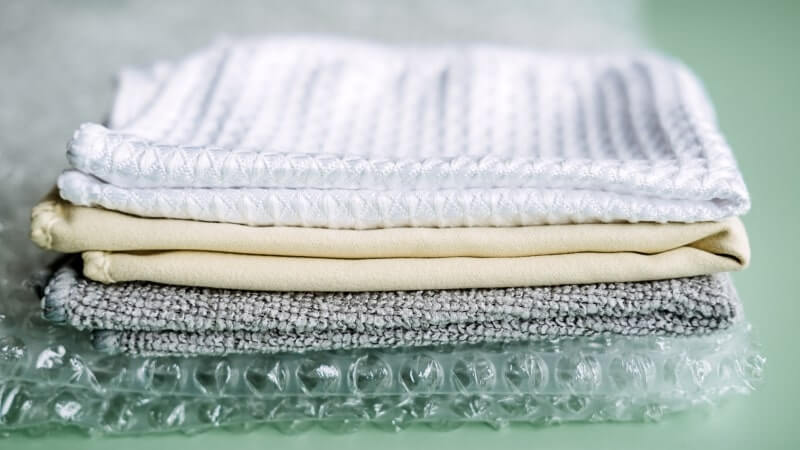
Not all poly-blends are equal, as each has a specific purpose. Some polyester fabrics are meant to be durable and water-resistant. Others need to be stretchy so the wearer can move comfortably.
Combining polyester with both natural and synthetic materials enhances its properties.
Let’s take a closer look at the three most common types of polyester blend fabrics.
Polyester-cotton blends
A polyester-cotton blend is one of the most popular materials in apparel manufacturing. Since this type of knitted polyester fabric is only slightly stretchy, it’s mainly suitable for everyday, low-performance activities.
These polyester-cotton fabrics combine the advantages of polyester, like durability and wrinkle resistance, with cotton’s natural softness and breathability.
Perfect for everyday t-shirts and casual wear, poly-cotton blends are a versatile choice for people looking for comfort without compromising on quality.
If you want your polyester clothing to feature the best of synthetic and natural materials, we recommend poly-cotton blends.
Check out these poly-cotton blends in our Catalog:
Polyester and spandex or elastane blends
Most designers will agree that adding spandex or elastane to polyester greatly enhances its flexibility, making it ideal for garments that demand stretch.
If you’re curious about what does polyester feel like when blended with spandex – it’s smooth, lightweight, and perfect for sportswear, swimwear, and leggings.
While polyester offers moisture-wicking properties to keep the wearer dry, spandex and elastane make sure the fabric retains its shape even after repeated stretching.
Altogether, it’s the perfect combo for cozy days at home or hardcore sessions at the gym.
A little goes a long way with spandex and elastane – you only need a bit to make polyester stretchy. Even adding 10% of elastane can stretch the whole fabric to almost double its size.
Popular polyester-spandex blend products on Printify include:
Triblends
This blended fabric uses three materials – cotton, polyester, and rayon.
Rayon, or viscose, is a semi-synthetic fiber manufactured from both human-made and natural materials, like cellulose derived from wood and other plant fibers.
It’s lightweight, breathable, and moisture-absorbent, but it’s the soft texture and the way it drapes that creates its unique feel.
Combined with the strength of polyester and the comfort of cotton, this fiber trio creates exceptionally comfortable garments.
Browse Printify triblend products like:
Does polyester stretch out or shrink after washing?
Polyester fibers are incredibly durable – regular washing, even in warm water, doesn’t harm 100% polyester fabrics.
It’s essentially plastic, so as long as you keep it away from very high temperatures, it’ll survive heavy use.
However, polyester blends can lose shape over time without proper care, so make sure to follow the washing instructions of your polyester garment.
All of Printify’s indoor and outdoor clothing has detailed care instructions in product descriptions, so your customers can enjoy their garments for many years.
Make it happen today!
Printing on polyester or natural fabrics
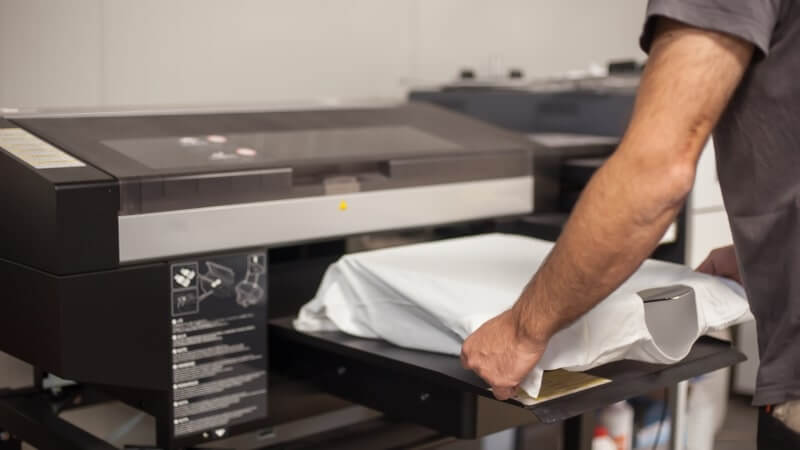
Both the printing method and fabric you choose as the canvas for your designs significantly impact the color vibrancy and durability.
Synthetic and natural fibers absorb dyes in very distinct ways, affecting how well the artwork holds up over time.
Check out our list of the best t-shirts for printing to make sure your designs last after wash and wear.
Direct-to-garment printing
It’s one of the top printing methods for custom t-shirts and other product types in Print On Demand to bring colorful and detailed designs to life.
These prints generally use water-based inks. Meanwhile, one of the properties of 100% polyester is being water-resistant.
This doesn’t mean that your artwork won’t stick to a polyester garment. The fabric just needs pretreatment to allow the ink to bond effectively.
It’s best to choose light-colored polyester garments for printing to make the design as vibrant as possible.
As an alternative, we have natural fibers that are water-absorbent by default. Cotton is the number one choice for printing with water-based inks as it fully absorbs them.
Sublimation printing
When printing on a polyester material, sublimation is the ideal technique. Unlike natural fibers, polyester absorbs sublimation ink seamlessly, creating vibrant and long-lasting designs. This highlights one of the key benefits of polyester – it bonds well with dye for bright, fade-resistant prints.
What other types of plastic fibers are there?
Synthetic fabrics have changed the game, making it easy to create durable, weatherproof, soft, and elastic garments.
Each fiber offers its own set of advantages, suitable for different types of clothing, home goods, and industrial products.
Let’s look at three of the most popular synthetic fibers and their characteristics.
Nylon
Nylon was the first synthetic fabric to reach mass production. It’s also one of the most versatile materials to make products ranging from apparel and upholstery to seat belts.
This durable fiber makes a very elastic fabric, is resistant to wrinkles, and shows remarkable resilience.
Find high-quality, ready-to-print nylon products in the Printify Catalog:
Acrylic
Acrylic is preferable when the cold weather hits because of its ability to retain heat. The material is a perfect substitute in polyester-wool blends because it’s moisture-resistant, easy to clean, soft, dries fast, and has a wool-like feel.
Thanks to its lightweight and shatter-resistant properties, it’s a popular choice for fall and winter accessories like hats, gloves, and scarves, as well as household items such as cups and storage containers.
Design and sell your own acrylic products with Printify:
Spandex
Apart from being resilient and very elastic – it can stretch more than five times its original size – spandex is extremely lightweight, tear-resistant, and doesn’t pill.
One of the reasons it’s so popular among hosiery manufacturers is that it also doesn’t create that annoying static cling.
Spandex makes polyester fabric stretchy, ideal for apparel that needs to be tight-fitting and comfortable, like activewear, swimwear, compression clothing, and pants.
Our Catalog features various items made with spandex, ready for custom-printing:
History of polyester
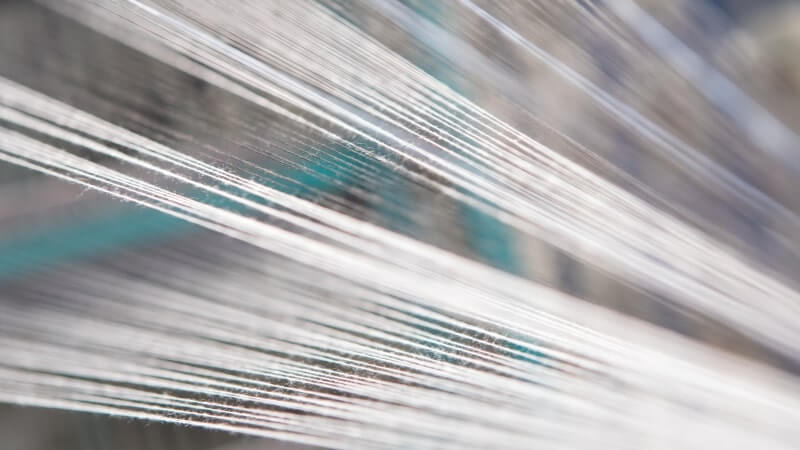
Polyester was first developed in the early 20th century and quickly became popular in textiles due to its durability, wrinkle resistance, and ease of care. The first polyester fiber, PET, was patented in the early 1940s, kickstarting its widespread use in mass markets.
Over the decades, technological advancements have led to better production methods and blends, making polyester fabric a staple in both fashion and industrial applications.
Today, this synthetic fabric is popular in clothing, home textiles, and various consumer products thanks to its versatility and affordability.
FAQ
Pure polyester isn’t stretchy since the plain weave of this synthetic fabric is designed to maintain shape and resist deformation.
Polyester combined with elastic fibers enhances flexibility and comfort, with knitted polyester fabrics offering the most stretch.
These polyester blends result in a stretchy fabric for a better fit, making them ideal for activewear and fitted garments.
Yes, it offers some degree of polyester stretch, especially when mixed with elastic materials like spandex or elastane.
But although these fibers add flexibility, most garments containing 90% of this synethic material will still have that polyester feel.
It generally feels smooth, lightweight, and has a somewhat synthetic texture compared to natural fibers.
Depending on the specific weave and finish, polyester can range from silky to more structured and crisp.
While it’s generally comfortable to wear, some people might find it less breathable than natural fabrics like cotton. Overall, the feel can vary based on the fabric’s treatment and design.
Polyester fabrics are not highly-flammable – they require more heat and take a while to ignite and than most fabrics. They do, however, start rapidly melting and dripping at very high temperatures.
Polyester starts melting at around 428°F (220°C) and ignites at 809.6°-910.4°F (432°-488°C).
Remember that blended fabrics contain other types of fibers, affecting how quickly the garment catches fire.
Be careful if you encounter burning polyester, as its fumes are toxic to humans and animals.
100% polyester clothes can last a lifetime with proper cared. Clothing manufacturers specifically use polyester to ensure that garments stick to their original form after wash and wear.
Another excellent quality of polyester fabric is that it doesn’t quickly fade in the sun.
Ensure you include care instructions for all your products containing polyester material and remind buyers not to iron, tumble dry, or wash them in hot temperatures.
It can be if it’s manufactured for that purpose. Polyester is made from solid plastic fibers that don’t let air through, so breathability is only achievable with woven polyester fabrics.
Woven fabrics designed for activewear often incorporate moisture-wicking properties that keep the wearer dry and comfortable, making them suitable for sports and hot weather. This is how you get polyester jersey and polyester fleece products.
Each polyester clothing item requires different care because it can feature various ratios of blended fibers. The general guideline for washing 100% polyester is to do it in cold water up to 90°F (30°C) with a detergent and fabric softener specifically made for synthetic fabrics.
We highly recommend against ironing and tumble drying polyester clothing on high heat and instead hanging clothes up to dry to avoid deformation. If you need to speed up the process, put your polyester apparel for a quick spin in the dryer.
Polyester is wrinkle-resistant by default, but it’s better to use steamer instead of a clothes iron if you need to smooth out creases.
Parting words
Are polyester fabrics stretchy? It depends on the type of blends and woven fabrics the product manufacturer uses.
Understanding polyester and its properties will help you make informed choices about which fabric to choose for clothing and other products.
Overall, polyester is an excellent, durable, and versatile fabric to use as a canvas for your designs. With Printify, creating custom polyester garments is easy.
Learn how to start a t-shirt business and start selling high-quality polyester blend garments in just a few clicks.



